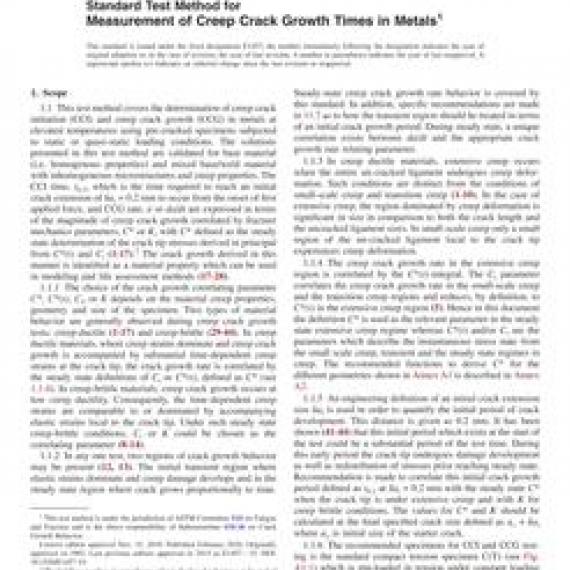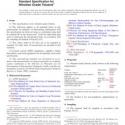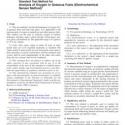No products
ASTM E1457-19
ASTM E1457-19 Standard Test Method for Measurement of Creep Crack Growth Times in Metals
standard by ASTM International, 11/15/2019
Full Description
1.1This test method covers the determination of creep crack initiation (CCI) and creep crack growth (CCG) in metals at elevated temperatures using pre-cracked specimens subjected to static or quasi-static loading conditions. The solutions presented in this test method are validated for base material (i.e. homogenous properties) and mixed base/weld material with inhomogeneous microstructures and creep properties. The CCI time, t0.2, which is the time required to reach an initial crack extension of ai=0.2 mm to occur from the onset of first applied force, and CCG rate, a or da/dt are expressed in terms of the magnitude of creep crack growth correlated by fracture mechanics parameters, C* or K, with C* defined as the steady state determination of the crack tip stresses derived in principal from C*(t) and Ct (1-17).2 The crack growth derived in this manner is identified as a material property which can be used in modeling and life assessment methods (17-28).
1.1.1The choice of the crack growth correlating parameter C*, C*(t), Ct, or K depends on the material creep properties, geometry and size of the specimen. Two types of material behavior are generally observed during creep crack growth tests; creep-ductile (1-17) and creep-brittle (29-44). In creep ductile materials, where creep strains dominate and creep crack growth is accompanied by substantial time-dependent creep strains at the crack tip, the crack growth rate is correlated by the steady state definitions of Ct or C*(t) , defined as C* (see 1.1.4). In creep-brittle materials, creep crack growth occurs at low creep ductility. Consequently, the time-dependent creep strains are comparable to or dominated by accompanying elastic strains local to the crack tip. Under such steady state creep-brittle conditions, Ct or K could be chosen as the correlating parameter (8-14).
1.1.2In any one test, two regions of crack growth behavior may be present (12, 13). The initial transient region where elastic strains dominate and creep damage develops and in the steady state region where crack grows proportionally to time. Steady-state creep crack growth rate behavior is covered by this standard. In addition, specific recommendations are made in 11.7 as to how the transient region should be treated in terms of an initial crack growth period. During steady state, a unique correlation exists between da/dt and the appropriate crack growth rate relating parameter.
1.1.3In creep ductile materials, extensive creep occurs when the entire un-cracked ligament undergoes creep deformation. Such conditions are distinct from the conditions of small-scale creep and transition creep (1-10). In the case of extensive creep, the region dominated by creep deformation is significant in size in comparison to both the crack length and the uncracked ligament sizes. In small-scale-creep only a small region of the un-cracked ligament local to the crack tip experiences creep deformation.
1.1.4The creep crack growth rate in the extensive creep region is correlated by the C*(t)-integral. The Ct parameter correlates the creep crack growth rate in the small-scale creep and the transition creep regions and reduces, by definition, to C*(t) in the extensive creep region (5). Hence in this document the definition C* is used as the relevant parameter in the steady state extensive creep regime whereas C*(t) and/or Ct are the parameters which describe the instantaneous stress state from the small scale creep, transient and the steady state regimes in creep. The recommended functions to derive C* for the different geometries shown in Annex A1 is described in Annex A2.
1.1.5An engineering definition of an initial crack extension size ai is used in order to quantify the initial period of crack development. This distance is given as 0.2 mm. It has been shown (41-44) that this initial period which exists at the start of the test could be a substantial period of the test time. During this early period the crack tip undergoes damage development as well as redistribution of stresses prior reaching steady state. Recommendation is made to correlate this initial crack growth period defined as t0.2 at ai = 0.2 mm with the steady state C* when the crack tip is under extensive creep and with K for creep brittle conditions. The values for C* and K should be calculated at the final specified crack size defined as ao + ai where ao is initial size of the starter crack.
1.1.6The recommended specimens for CCI and CCG testing is the standard compact tension specimen C(T) (see Fig. A1.1) which is pin-loaded in tension under constant loading conditions. The clevis setup is shown in Fig. A1.2 (see 7.2.1 for details). Additional geometries which are valid for testing in this procedure are shown in Fig. A1.3. These are the C-ring in tension CS(T), middle crack specimen in tension M(T), single edge notched tension SEN(T), single edge notched bend SEN(B), and double edge notched tension DEN(T). In Fig. A1.3, the specimens side-grooving-position for measuring displacement at the force-line displacement (FLD) and crack mouth opening displacement (CMOD) and positions for the electric potential drop (EPD) input and output leads are shown. Recommended loading for the tension specimens is pin-loading. The configurations, size range are given in Table A1.1 of Annex A1, (43-47). Specimen selection will be discussed in 5.9.
1.1.7The state-of-stress at the crack tip may have an influence on the creep crack growth behavior and can cause crack-front tunneling in plane-sided specimens. Specimen size, geometry, crack length, test duration and creep properties will affect the state-of-stress at the crack tip and are important factors in determining crack growth rate. A recommended size range of test specimens and their side-grooving are given in Table A1.1 in Annex A1. It has been shown that for this range the cracking rates do not vary for a range of materials and loading conditions (43-47). Suggesting that the level of constraint, for the relatively short term test durations (less than one year), does not vary within the range of normal data scatter observed in tests of these geometries. However, it is recommended that, within the limitations imposed on the laboratory, that tests are performed on different geometries, specimen size, dimensions and crack size starters. In all cases a comparison of the data from the above should be made by testing the standard C(T) specimen where possible. It is clear that increased confidence in the materials crack growth data can be produced by testing a wider range of specimen types and conditions as described above.
1.1.8Material inhomogeneity, residual stresses and material degradation at temperature, specimen geometry and low-force long duration tests (mainly greater that one year) can influence the rate of crack initiation and growth properties (42-50). In cases where residual stresses exist, the effect can be significant when test specimens are taken from material that characteristically embodies residual stress fields or the damaged material, or both. For example, weldments, or thick cast, forged, extruded, components, plastically bent components and complex component shapes, or a combination thereof, where full stress relief is impractical. Specimens taken from such component that contain residual stresses may likewise contain residual stresses which may have altered in their extent and distribution due to specimen fabrication. Extraction of specimens in itself partially relieves and redistributes the residual stress pattern; however, the remaining magnitude could still cause significant effects in the ensuing test unless post-weld heat treatment (PWHT) is performed. Otherwise residual stresses are superimposed on applied stress and results in crack-tip stress intensity that is different from that based solely on externally applied forces or displacements. Not taking the tensile residual stress effect into account will produce C* values lower than expected effectively producing a faster cracking rate with respect to a constant C*. This would produce conservative estimates for life assessment and non-conservative calculations for design purposes. It should also be noted that distortion during specimen machining can also indicate the presence of residual stresses.
1.1.9Stress relaxation of the residual stresses due to creep and crack extension should also be taken into consideration. No specific allowance is included in this standard for dealing with these variations. However the method of calculating C* presented in this document which used the specimens creep displacement rate to estimate C* inherently takes into account the effects described above as reflected by the instantaneous creep strains that have been measured. However extra caution should still be observed with the analysis of these types of tests as the correlating parameters K and C* shown in Annex A2 even though it is expected that stress relaxation at high temperatures could in part negate the effects due to residual stresses. Annex A4 presents the correct calculations needed to derive J and C* for weldment tests where a mis-match factor needs to be taken into account.
1.1.10Specimen configurations and sizes other than those listed in Table A1.1 which are tested under constant force will involve further validity requirements. This is done by comparing data from recommended test configurations. Nevertheless, use of other geometries are applicable by this method provided data are compared to data obtained from standard specimens (as identified in Table A1.1) and the appropriate correlating parameters have been validated.
1.2The values stated in SI units are to be regarded as the standard. The inch-pound units given in parentheses are for information only.
1.3This standard does not purport to address all of the safety concerns, if any, associated with its use. It is the responsibility of the user of this standard to establish appropriate safety, health, and environmental practices and determine the applicability of regulatory limitations prior to use.
1.4This international standard was developed in accordance with internationally recognized principles on standardization established in the Decision on Principles for the Development of International Standards, Guides and Recommendations issued by the World Trade Organization Technical Barriers to Trade (TBT) Committee.


































